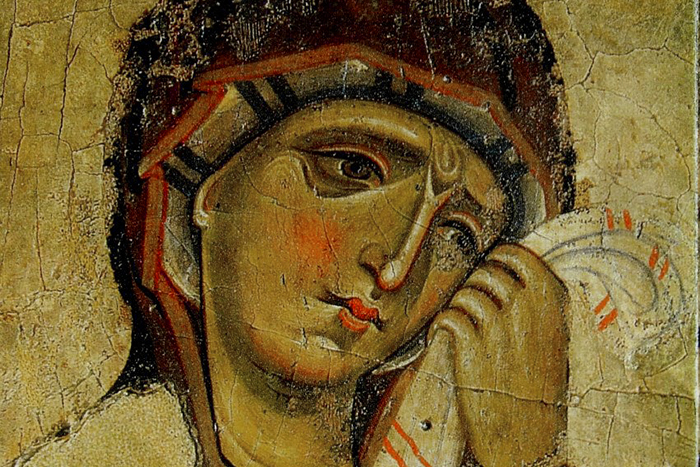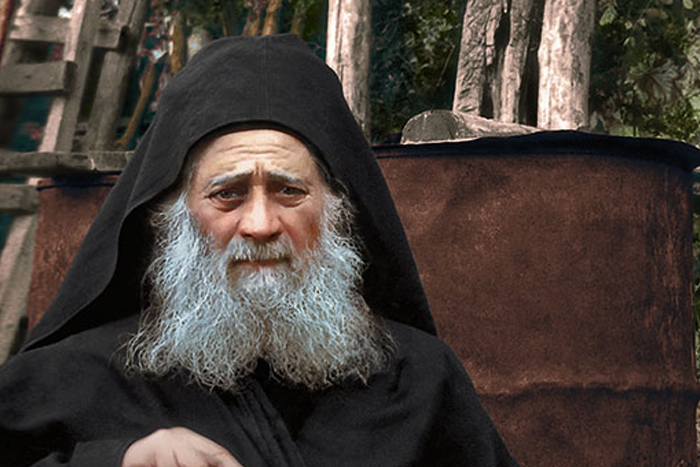
Recently, a friend e-mailed me and asked if Orthodox Christians believe that Mary was “perpetually a virgin.” The short answer is, yes!
The long answer is a bit more complex. I’ve pasted my response below, which I hope you can follow.
It basically has to do with the fact that the Old Testament Temple is a symbol of Mary, and Ezekiel says that the gate of the Temple remains closed, even when the Lord passes through. This becomes a reflection for Orthodox theologians to wonder why Mary, through this imagery, would be “ever-virgin.”
In addition, Mary is a symbol for the Church, which is called to constantly be “birthing” new Christians. However, Christians are “born” into the Church not biologically, but by faith. Thus, the biological element is removed and Mary, as a symbol of the Church, remains a virgin.
The full argument is below. I pray it gives you a glimpse into Orthodox thought.
Virginity as Theology Not Biology
The question of the virginity of Mary is a good one, and it’ll be hard to explain it in full on a blog. However, I’ll do my best to give you the highlights.
The question of Mary’s virginity is usually asked in the wrong way. It’s usually asked with the intent of *historicity*, meaning, “Biologically was she a virgin?”
However, the interest for the Orthodox is not in biology (not that biology doesn’t matter), but rather in theology. If the claim is made that she is a perpetual virgin, then the “Orthodox” question is, “What does this mean theologically?” or “What’s the theological significance of this
virginity?”
The Temple and the Virgin
The answer to the “Orthodox question” delves deeply into the imagery of the Virgin Mary.
As you know, much of our hymnography is poetic and, as such, heavily uses symbolism.
One such symbol comes from the Old Testament. Here, the Temple is a symbol of Mary, or, to use the language of literature, the Temple foreshadows the Virgin.
As you know, the Temple was the presence of God among the Israelites. God’s presence dwelt in the Holy of Holies with the Ark of the Covenant as his “footstool,” if you will. Mary becomes the “new Temple” because now God dwells among us through the Incarnation. The “Holy of Holies” is now Mary’s womb because this is where God “dwelt” for nine months.
This is corroborated in the Gospel of John. Most translations translate 1:14 something like this, “And the Word became flesh and lived among us” (NRSV). This, however, is not what the Greek says. A better translation is something like this, “And the Word became flesh and Tabernacled among us.”
The Tabernacle, of course, is the tent that functioned as the Temple before the Temple was built. In other words, John is making a direct connection between the Temple (and God’s presence dwelling there) and the Incarnation.
Mary and the Church
Mary and symbolism goes even deeper.
Just as the Temple was a symbol of Mary, Mary becomes an image of the Church. This is because Paul calls the Church, those gathered together, the “Body of Christ.”
So, the role of the Church is constantly to “give birth” to the Body of Christ, that is, new Christians. So, if the Church is constantly giving birth to the Body of Christ, then it’s only natural that Mary is the symbol of the Church.
Perpetual Virginity
Now, the perpetual virginity part–if you’re still with me.
Ezekiel, who wrote after the destruction of the First Temple, describes the creation of a new celestial Temple. Since we now know that the Temple is an image of Mary, we can say that Ezekiel’s prophecy is a poetic rendering of the Mary and the Incarnation of Jesus. At one point he writes this (this is the end of chapter 43 and very beginning of 44),
“Then he brought me back to the outer gate of the sanctuary, which faces east; and it was shut. And the Lord said to me, ‘This gate shall remain shut; it shall not be opened, and no one shall enter by it; for the Lord, the God of Israel, shall enter by it; therefore it shall remain shut. Only the prince shall sit in it to eat bread before the Lord; he shall enter by way of the vestibule of the gate, and shall go out by the same way.’ Then he brought me by way of the north gate to the front of the temple; and I looked, and behold, the glory of the Lord filled the house of the Lord.”
This “closed gate,” if we’re talking about Mary, is her perpetual virginity. So, Orthodox exegetes now have to ask “Why is the gate closed, what does this mean?”
I believe the Orthodox theologian Fr. John McGuckin, in his book The Orthodox Church, sums it up nicely,
“The church’s assertion of Mary’s perpetual virginity is a strong statement that the annunciation, the birth, and the very person of Jesus her son are transcendent. He is the virgin Son of the virgin Mother, and his life and person are not reducible to that of a Jewish Meditternean sage, wholly explicable from and within his own historical culture.” (pg. 215).
In other words, the virginity of Mary is a theological statement about Jesus being the Son of God rather than the son of Joseph.
Virginity as an Image of “Birth Through Faith”
Her perpetual virginity, I think, also has to do with the fact that she is–as a symbol of the Church–the mother of all Christians, who are made “sons of God” not by biological birth, but by faith (baptism being our “birth by faith”).
Birth by faith, rather than biology, is another Old Testament image. The only patriarch to fully embrace God’s promise of the Promised Land, was Isaac (all the other patriarchs end up fleeing to Egypt or elsewhere for “protection” rather than trusting in God). So, Isaac holds a special place.
And, I’m sure you know the story of his birth. Abraham and Sara were visited by three angels who predicted Isaac’s birth. Sara laughs at them because of her extreme old age. When the time comes for Isaac to be born however, the normal formula of “husband knows his wife” is missing.
Instead, the text says, “The Lord dealt with Sarah as he had said, and the Lord did for Sarah as he had promised” (Gen. 21:1). In other words, according to scripture, Isaac is not the biological son of Abraham. Instead, Isaac is the son of God’s Promise, that is, faith.
Paul then picks up on this in the New Testament. Christians become the “sons of God,” not by biological birth, but by “faith” (born just like Isaac). So, if we’re talking about faith, sex is not involved and so Mary–as the symbol of the Church–remains a perpetual virgin giving birth through faith rather than biology.
Mary, the Ever-Virgin
So, to bring it all together, the authors of the New Testament, and the early Christians, understood the Temple as foreshadowing Mary. And, when these early Christians searched scripture, they found that Mary was a Virgin. This led them to theologically reflect on why this might be.
What they discovered is a statement about who Jesus is and about the nature of his relationship to his heavenly Father.
In addition, these early Christians also understood Mary to be an image of the Church, which is called to constantly be “birthing” new Christians, or, to put it another way, the Body of Christ.
Since this birth is by faith, and not “husbands knowing wives,” the biological element is removed so Mary, as an image of the Church, is a perpetual virgin.



